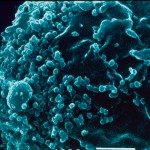Link to Pubmed [PMID] – 25589645
J. Virol. 2015 Apr;89(7):3542-56
UNLABELLED: The spontaneous control of human and simian immunodeficiency viruses (HIV/SIV) is typically associated with specific major histocompatibility complex (MHC) class I alleles and efficient CD8(+) T-cell responses, but many controllers maintain viral control despite a nonprotective MHC background and weak CD8(+) T-cell responses. Therefore, the contribution of this response to maintaining long-term viral control remains unclear. To address this question, we transiently depleted CD8(+) T cells from five SIV-infected cynomolgus macaques with long-term viral control and weak CD8(+) T-cell responses. Among them, only one carried the protective MHC allele H6. After depletion, four of five controllers experienced a transient rebound of viremia. The return to undetectable viremia was accompanied by only modest expansion of SIV-specific CD8(+) T cells that lacked efficient SIV suppression capacity ex vivo. In contrast, the depletion was associated with homeostatic activation/expansion of CD4(+) T cells that correlated with viral rebound. In one macaque, viremia remained undetectable despite efficient CD8(+) cell depletion and inducible SIV replication from its CD4(+) T cells in vitro. Altogether, our results suggest that CD8(+) T cells are not unique contributors to the long-term maintenance of low viremia in this SIV controller model and that other mechanisms, such as weak viral reservoirs or control of activation, may be important players in control.
IMPORTANCE: Spontaneous control of HIV-1 to undetectable levels is associated with efficient anti-HIV CD8(+) T-cell responses. However, in some cases, this response fades over time, although viral control is maintained, and many HIV controllers (weak responders) have very low frequencies of HIV-specific CD8(+) T cells. In these cases, the importance of CD8 T cells in the maintenance of HIV-1 control is questionable. We developed a nonhuman primate model of durable SIV control with an immune profile resembling that of weak responders. Transient depletion of CD8(+) cells induced a rise in the viral load. However, viremia was correlated with CD4(+) T-cell activation subsequent to CD8(+) cell depletion. Regain of viral control to predepletion levels was not associated with restoration of the anti-SIV capacities of CD8(+) T cells. Our results suggest that CD8(+) T cells may not be involved in maintenance of viral control in weak responders and highlight the fact that additional mechanisms should not be underestimated.



